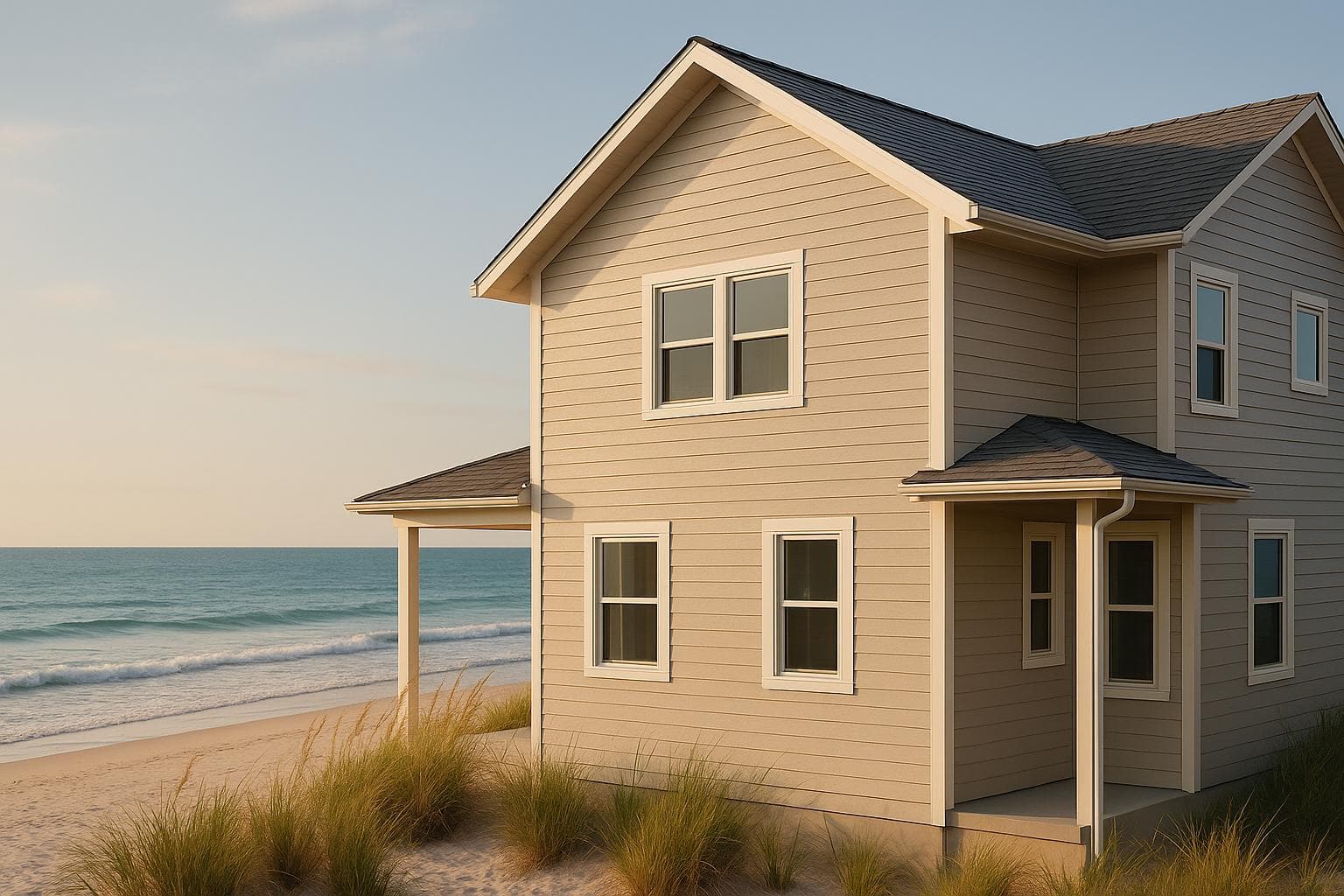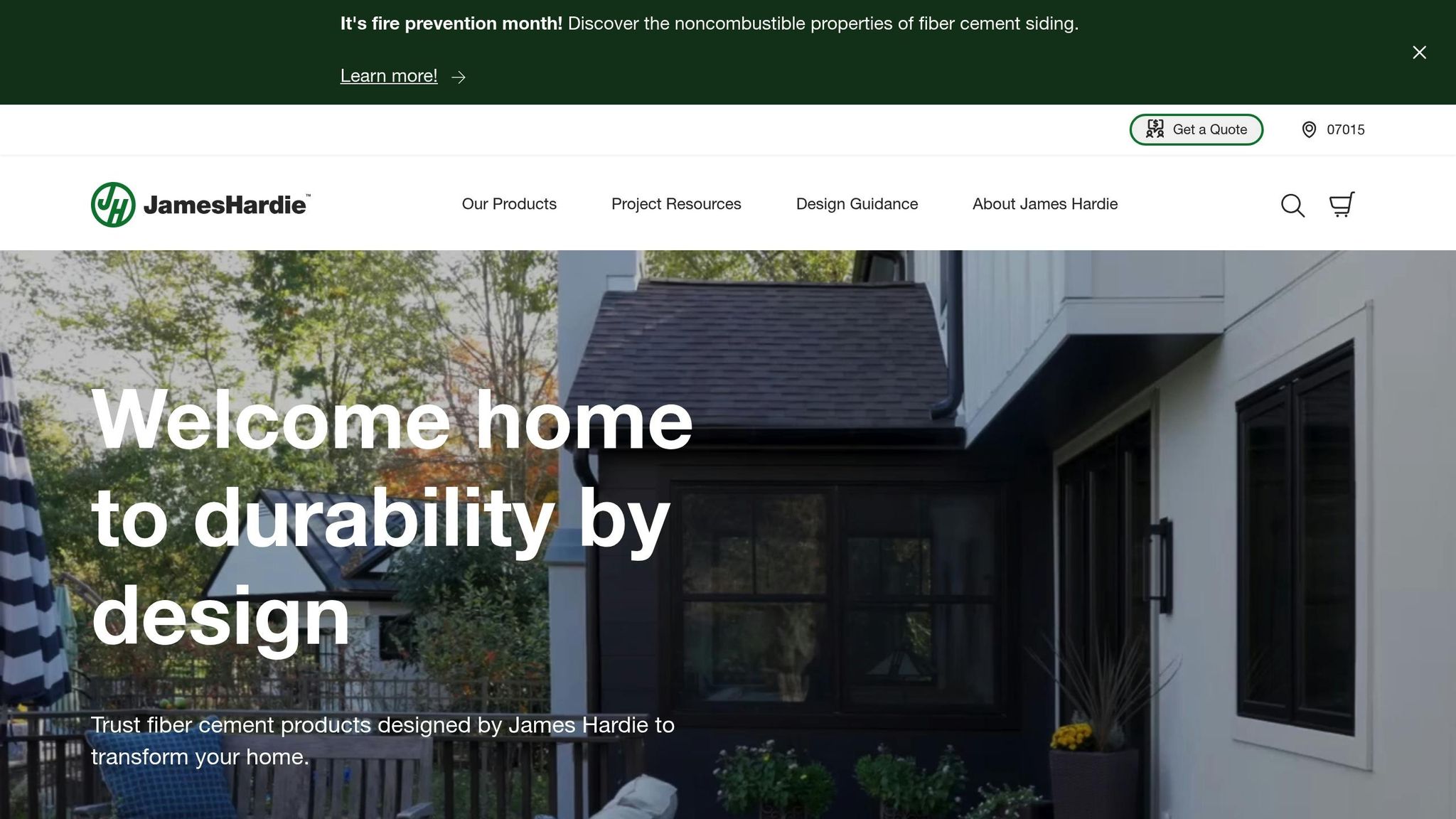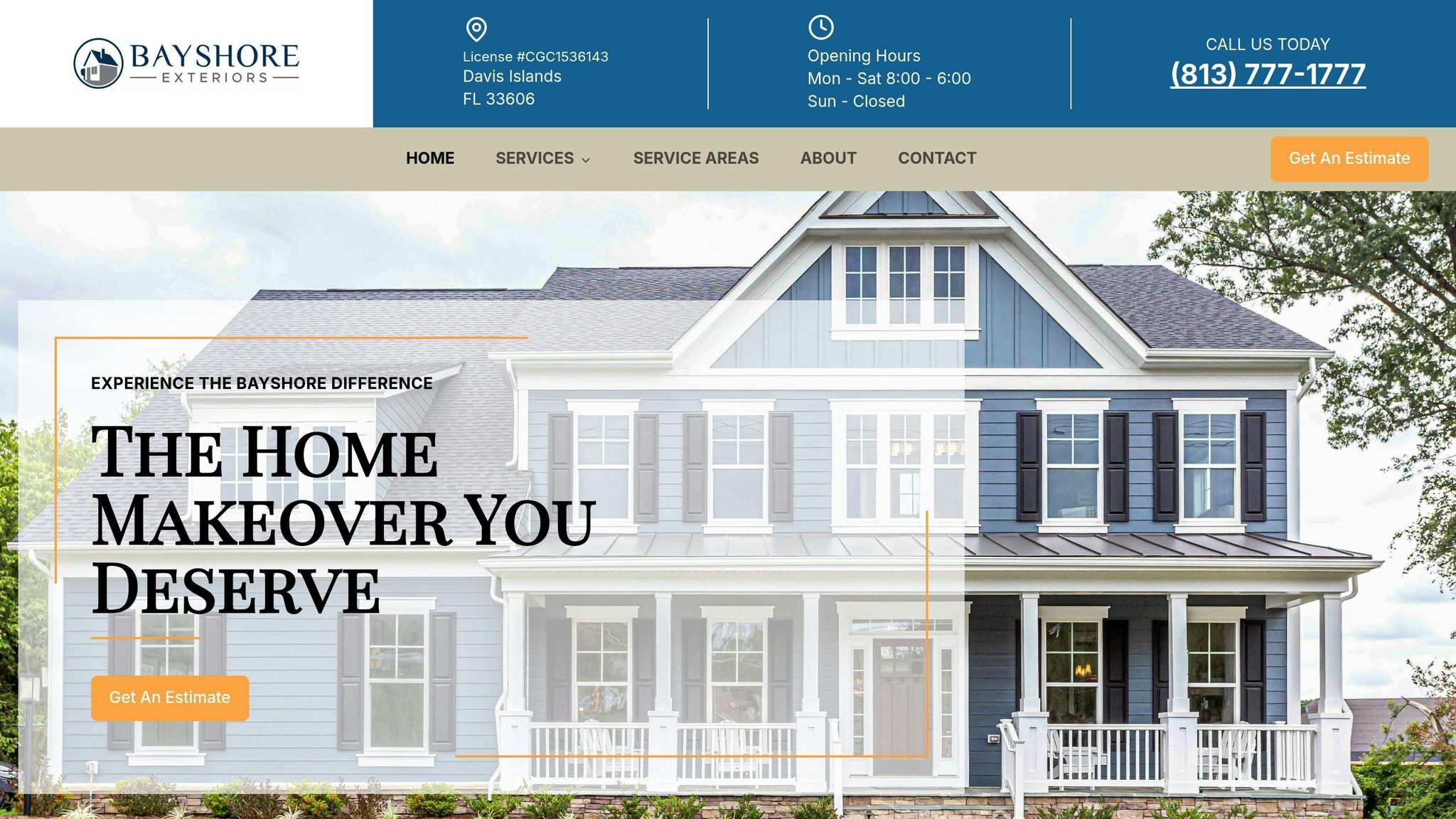


Salt Air vs. Siding: Protecting Coastal Tampa Bay Homes from Corrosion

Make an appointment
Get a Free Estimate Today
Salt Air vs. Siding: Protecting Coastal Tampa Bay Homes from Corrosion
Living near Tampa Bay’s coast offers beautiful views and ocean air, but it also brings challenges for homeowners - particularly salt air damage to home siding. Salt particles in the air can corrode materials, shorten the lifespan of siding, and increase maintenance costs. Even homes miles from the water are at risk.
Key Takeaways:
- Salt air damage: Causes corrosion, chalking, warping, and cracking in siding materials.
- Vulnerable materials: Wood, vinyl, and improperly sealed fiber cement are especially prone to damage.
- Best options: James Hardie fiber cement siding resists salt, moisture, and Florida’s intense climate.
- Maintenance tips: Regular cleaning, protective coatings, and seasonal inspections can extend siding life.
Investing in durable siding and proper care is essential for protecting coastal homes. James Hardie’s HZ10® line, combined with expert installation from Bayshore Exteriors, offers long-term protection against Tampa Bay’s harsh conditions.
How Do I Clean Hardie Board Siding?
Best Siding Materials for Coastal Tampa Bay Homes
When it comes to siding for your Tampa Bay home, the right choice can make all the difference in standing up to salt air, humidity, and the demands of a coastal environment. The right siding not only protects your home but also enhances its curb appeal. Let’s dive into the top materials that can handle coastal conditions while keeping your home looking great.
Fiber Cement Siding: A Durable Favorite
Fiber cement siding is a standout option for coastal homes. Made from a mix of cement, sand, and cellulose fibers, this material is engineered to handle harsh environments. Unlike wood siding, which can swell or warp when exposed to salty air and moisture, fiber cement stays stable and durable.
One of the best-known products in this category is James Hardie's HZ10® line, which is specifically designed for coastal conditions. It’s built to withstand salt air, strong winds, and high humidity. Its moisture resistance also helps keep salt deposits from seeping in and causing damage.
Another perk? James Hardie’s ColorPlus® Technology offers a baked-on, UV-resistant finish that resists fading, peeling, chipping, and cracking better than traditional paint. And for added peace of mind, fiber cement siding is fire-resistant, meaning it won’t ignite or contribute fuel in the event of a fire.
Other Siding Options That Work in Coastal Areas
While fiber cement is a top pick, there are other materials worth considering for homes near the coast:
- High-grade vinyl siding: This option includes UV stabilizers to help it hold up in coastal climates. It won’t rust or rot, but it may need frequent cleaning to remove salt buildup and prevent chalking. Over time, prolonged exposure to salt air and Florida’s intense sun could make the material brittle.
- Engineered wood siding: These products, when properly sealed and finished with marine-grade coatings, can be a budget-friendly alternative. However, they require consistent maintenance, such as refinishing and regular inspections, to stay in good condition.
Key Factors to Consider When Choosing Siding
When selecting siding for your coastal Tampa Bay home, keep these key factors in mind:
- Moisture Resistance: Opt for materials that are proven to perform well in marine environments.
- Maintenance Needs: Weigh the upfront costs of materials and installation against the long-term upkeep they’ll require.
- Warranty: A strong warranty can give you added confidence in the product’s durability and performance.
- Installation: Some materials need special fasteners, sealants, or techniques to ensure they perform well in salty air.
- Aesthetic Longevity: Look for finishes specifically tested to retain their color and appearance in coastal conditions.
How to Protect and Maintain Your Siding
Even the best coastal siding needs regular care to stand up to Tampa Bay's salty air. By keeping up with routine maintenance and addressing issues promptly, you can extend its lifespan and keep your home looking great. Here’s how you can protect your siding and get the most out of your investment.
Regular Cleaning and Problem Spotting
Salt buildup isn’t just a cosmetic issue - it’s a real threat to the integrity of your siding. Over time, salt particles can wear down protective finishes and even the siding material itself. That’s why regular cleaning is essential.
Aim to clean your siding every three months. Use a garden hose and mild detergent, starting at the top and working your way down. Pay extra attention to areas prone to salt buildup, like eaves and window surrounds. For stubborn salt deposits, grab a soft-bristled brush and some warm water mixed with dish soap.
While cleaning, take the opportunity to inspect for potential problems. Look for chalky salt residue, cracks, fading, or missing caulk around seams and joints. Don’t forget to check areas around fastener heads, where salt and moisture tend to collect. Address any issues right away to avoid further damage. After cleaning, consider applying protective coatings to strengthen your siding's resistance to salt.
Protective Coatings and Treatments
Cleaning is just the first step - protective treatments can add an extra layer of defense. High-quality coatings are designed to shield your siding from Tampa Bay’s salty air and humid conditions.
Consider using marine-grade paints, zinc-rich primers, or epoxy sealants. These products are specifically formulated to resist corrosion caused by salt spray and moisture. Seal any gaps, edges, or fastener heads with durable exterior caulk. If you have wood siding, opt for preservative-treated wood and apply protective finishes to guard against water damage and decay. Any cuts or holes in the wood should also be treated to prevent moisture from seeping in.
Repainting every few years is another way to refresh your siding’s protective barrier. While the exact timing depends on your home’s exposure to the elements, most homes in Tampa Bay benefit from a repainting cycle of about 3-5 years.
Seasonal Care Tips for Tampa Bay Homeowners
Tampa Bay's climate brings unique challenges, so it’s important to adjust your maintenance routine with the seasons:
- Spring: Give your siding a thorough cleaning, check for any damage from winter, and apply protective coatings as needed.
- Summer: After storms, inspect for loose siding or damaged caulk, and clear gutters to reduce salt buildup.
- Hurricane Season: Secure all panels, verify protective coatings, and rinse your siding with fresh water after storms to remove salt deposits.
- Fall/Winter: Focus on routine maintenance, as cooler, drier weather is ideal for repainting and making repairs.
sbb-itb-85e0110
James Hardie Siding: Top Choice for Tampa Bay Homes

Living near the coast has its perks - breathtaking views, ocean breezes - but it also comes with challenges for homeowners. Coastal homes face relentless exposure to salt air, humidity, and harsh weather. That’s where James Hardie fiber cement siding steps in, offering a durable, low-maintenance solution built to handle these tough conditions.
Why James Hardie Siding Excels in Coastal Climates
James Hardie’s HZ10® product line was specifically created for regions like Tampa Bay, where salt air and extreme weather are constant concerns. As the company explains:
"This siding was engineered for areas with hurricane-force winds, salty sea air of the coast, and the brutal, humid heat of the Deep South. Engineered specifically for these climates, HZ10® boards resist cracking, splitting, rotting and swelling season after hot, humid, tropical storm season."
The secret to its durability lies in its fiber cement composition - a mix of cement, cellulose fibers, water, and proprietary additives. This combination ensures excellent resistance to moisture and salt damage. Each board is meticulously cured at high temperatures and designed with multiple layers to reduce expansion and moisture absorption. This not only protects against salt penetration but also preserves the siding's structural integrity over time.
Adding to its strength is ColorPlus® Technology, a baked-on color system that resists fading from Florida’s intense UV rays. This finish not only keeps your home looking vibrant but also simplifies cleaning by sealing in moisture, making it easier to remove salt buildup. Together, these features make James Hardie siding a standout choice for coastal homes.
Other key benefits include:
- Wind resistance up to 150 mph, making it ideal for hurricane-prone areas.
- FEMA certification for flood resistance.
- A Class A fire rating, thanks to its noncombustible material.
- Natural pest resistance, keeping termites and carpenter ants at bay - an especially valuable feature in humid climates.
Bayshore Exteriors: Expert Installation for Maximum Performance

Even the most durable siding won’t perform its best without proper installation. That’s where Bayshore Exteriors comes in. With extensive experience working on coastal properties in the Tampa Bay area, their team specializes in installing James Hardie siding to meet the unique demands of the region.
Their professional installation process covers every detail:
- Proper flashing around windows and doors to prevent water intrusion.
- Allowing for thermal expansion to accommodate Florida’s heat.
- Sealing joints and fasteners to block salt infiltration effectively.
Beyond installation, Bayshore Exteriors also provides consulting and planning services, helping homeowners select the ideal James Hardie products for their specific needs. Their custom siding makeovers not only enhance your home’s look but also ensure long-term protection against salt air and weather-related damage.
Siding Material Comparison for Coastal Homes
Choosing the right siding for your Tampa Bay home involves considering factors like durability, resistance to salt air, maintenance needs, and long-term performance. Coastal conditions can accelerate material wear, so it’s essential to evaluate the balance between upfront costs and the value each option provides over time. Below, we’ve outlined how various siding materials perform in coastal environments, along with a detailed comparison chart.
Siding Materials Comparison Chart for Coastal Conditions
Here’s a side-by-side look at how popular siding materials hold up in coastal settings:
| Material | Salt Resistance | Maintenance | Lifespan | Appearance Options | Wind Resistance |
|---|---|---|---|---|---|
| Fiber Cement (James Hardie) | Excellent | Low-maintenance | Long-lasting | Wide variety of textures and colors | Superior |
| PVF-Coated Metal | Strong | Moderate | Durable | Limited color options, modern aesthetic | High |
| Vinyl | Good | Affordable | Moderate | Broad range of colors, fewer texture options | Adequate |
| Wood | Vulnerable | High-maintenance | Shorter lifespan | Classic natural look with customizable finishes | Lower |
Fiber cement siding, such as James Hardie products, is a standout choice for coastal homes. Its cement-based composition resists salt penetration, making it a long-lasting option that reduces replacement costs and enhances overall protection. Its wide range of textures and colors also allows homeowners to customize the look of their property without compromising on performance.
PVF-coated metal siding offers strong resistance to salt air but requires regular upkeep to maintain its protective coating. Any damage to the coating can speed up wear, so careful maintenance is crucial.
Vinyl siding is a cost-effective option with a variety of color choices. However, it’s worth noting that prolonged exposure to coastal conditions can make vinyl brittle over time, potentially reducing its durability.
Wood siding, while offering a timeless and natural aesthetic, is less practical for coastal environments. Salt air, high humidity, and harsh weather often lead to rot, warping, and other issues, making wood a high-maintenance and less durable choice.
When it comes to wind resistance - an especially important factor during hurricane season - fiber cement siding leads the pack. Its ability to withstand strong winds provides added peace of mind, helping protect your home from severe weather and water damage.
While fiber cement siding may come with a higher initial price tag, its durability, low maintenance needs, and performance in coastal conditions make it a worthwhile investment for Tampa Bay homeowners.
Conclusion: Protect Tampa Bay Homes with Bayshore Exteriors
Living near the coast has its perks, but it also comes with challenges - like salt air corrosion, which can lead to costly repairs and even reduce your home's value if left unchecked.
That’s where James Hardie fiber cement siding shines. Designed specifically for coastal conditions, this siding resists salt damage and tough weather, while requiring minimal upkeep. Pair that with regular rinsing and quick repairs, and you’ve got a recipe for long-lasting protection.
Of course, even the best materials need expert installation to deliver their full potential. That’s where Bayshore Exteriors comes in. From James Hardie siding installation to full exterior remodeling, we specialize in safeguarding Tampa Bay homes. Our services also include roofing, windows, porches, decks, and lighting solutions - everything you need to keep your home protected and looking its best.
Ready to shield your home from the elements? Reach out to Bayshore Exteriors today. Whether you’re starting fresh with new construction or upgrading your existing siding, professional installation ensures your investment stands strong. Don’t wait - schedule your consultation now and give your home the protection it deserves.
FAQs
How can I protect my home's siding from salt air damage in Tampa Bay's coastal environment?
To keep your home's siding in good shape despite Tampa Bay's salty air, here are some practical maintenance tips:
- Rinse your siding with fresh water on a regular basis. This helps remove salt buildup, which can lead to corrosion or discoloration.
- Check your siding for damage like cracks, warping, or other wear and tear. Addressing these issues quickly can prevent bigger problems down the road.
- Refresh protective coatings or finishes as needed, especially on materials like wood or aluminum. This adds an extra layer of defense against the elements.
- Trim back vegetation near your home. Overgrown plants can trap moisture, creating a perfect environment for mildew or mold to grow on your siding.
- Clean out gutters and downspouts. Clogged gutters can cause water to overflow, which may damage your siding over time.
By staying on top of these simple tasks, you can protect your siding and keep your home looking its best in Tampa Bay's coastal environment.
How does James Hardie fiber cement siding hold up against vinyl and wood in Tampa Bay's coastal conditions?
James Hardie fiber cement siding is designed to handle the tough conditions that come with living in coastal areas, making it a smart option for homeowners in Tampa Bay. Unlike wood siding, which can soak up moisture and eventually rot, or vinyl siding, which might warp or even melt under intense heat, fiber cement siding stands strong against moisture, pests, and shifting temperatures. Its mix of cement, sand, water, and cellulose fibers creates a tough barrier that holds up well against the salty air and high humidity typical of coastal environments.
On top of that, James Hardie siding is fire-resistant and built to endure strong winds - both crucial features for homes in coastal regions. It also demands less upkeep than wood and outperforms vinyl in durability, offering a long-term solution for homes near the water.
Why should I choose Bayshore Exteriors to install James Hardie siding for my coastal Tampa Bay home?
Bayshore Exteriors proudly offers James Hardie siding, a standout option for coastal homes in Tampa Bay. Known for its toughness and ability to handle harsh coastal conditions, this siding is specifically crafted to endure salt air, heavy moisture, and extreme weather. It not only protects your home but also keeps it looking great over time.
When installed by the skilled team at Bayshore Exteriors, James Hardie siding delivers exceptional resistance to wind, pests, and even fire. Thanks to its ColorPlus Technology, the siding retains its vibrant color with minimal upkeep - perfect for homeowners seeking a low-maintenance solution. Bayshore Exteriors provides expert installation tailored to your home's specific requirements, ensuring your property remains durable and visually appealing for years to come.